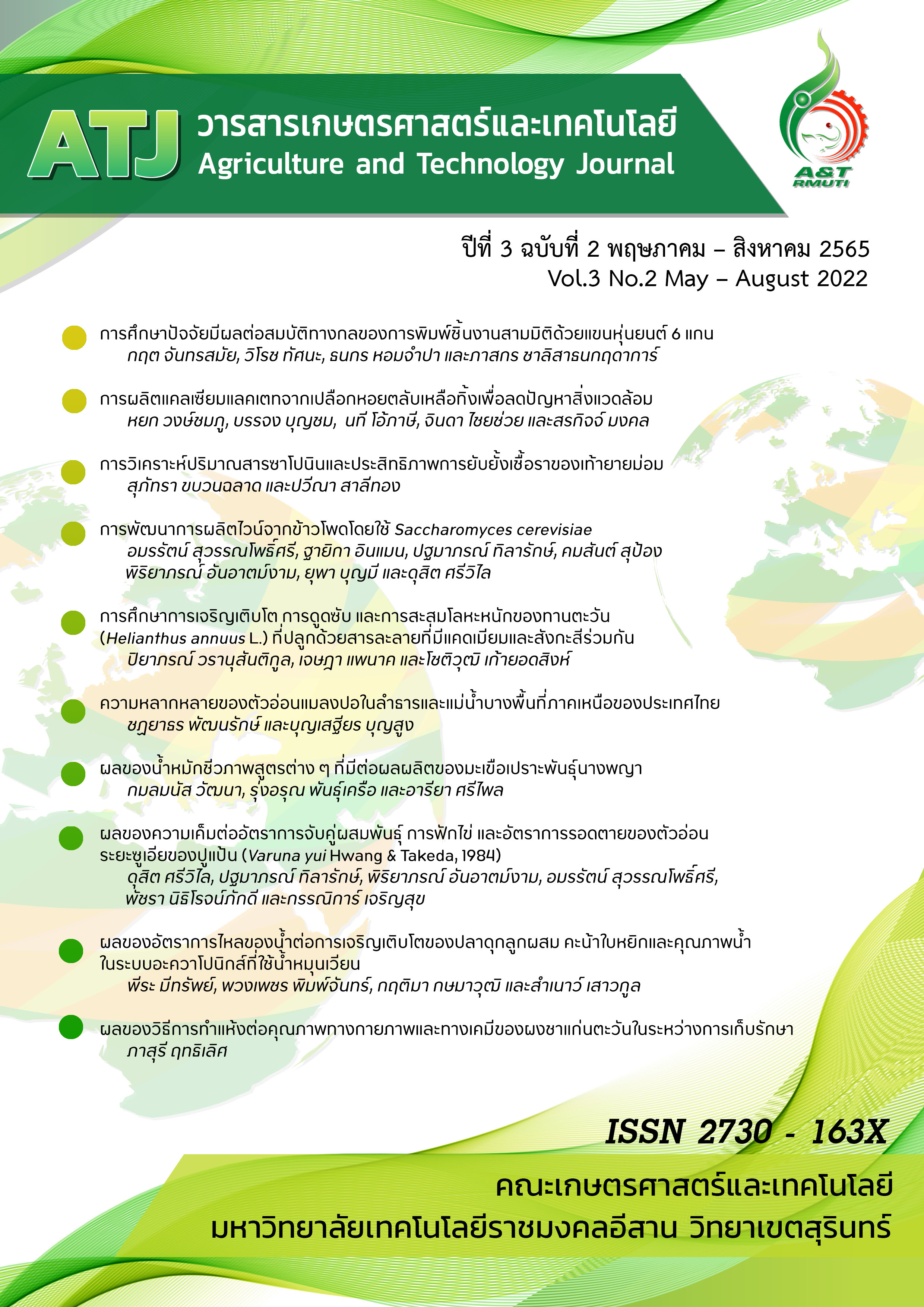การวิเคราะห์ปริมาณสารซาโปนินและประสิทธิภาพการยับยั้งเชื้อราของเท้ายายม่อม
Analysis of saponin content and antifungal activity of East Indian Arrowroot
คำสำคัญ:
ต้านเชื้อรา , เท้ายายม่อม , ซาโปนินบทคัดย่อ
เท้ายายม่อมเป็นไม้ล้มลุกอายุหลายปี มีหัวใต้ดินสำหรับสะสมอาหาร ประเทศไทยนิยมใช้หัวของเท้ายายม่อมในการทำแป้งสำหรับประกอบอาหารโดยเฉพาะอาหารหวาน ในขณะที่ส่วนใบ ลำต้น และส่วนอื่น ๆ ไม่มีการนำไปใช้ประโยชน์ ซึ่งจากการสกัดตัวอย่างใบ ลำต้น และผลของเท้ายายม่อมด้วยตัวทำละลายเอทานอล พบว่าส่วนของผลให้ปริมาณสารสกัดหยาบมากที่สุด รองลงมาคือ ใบ และลำต้น ซึ่งเมื่อนำสารสกัดหยาบมาแยกและทดสอบชนิดของสารซาโปนินด้วยวิธี Liebermann-Burchard Test และวิเคราะห์หมู่ฟังก์ชันของสารสกัดด้วยเทคนิคอินฟราเรดสเปกโทรสโคปี พบว่าสารสกัดประกอบด้วย
สารซาโปนินประเภทไตรเทอร์ปีนอยด์ โดยใบจะมีปริมาณสารซาโปนินมากที่สุด (23.44 ไมโครกรัมต่อกรัมตัวอย่างแห้ง) รองลงมาคือ ผล (19.73 ไมโครกรัมต่อกรัมตัวอย่างแห้ง) และลำต้นของเท้ายายม่อม (7.79 ไมโครกรัมต่อกรัมตัวอย่างแห้ง) และเมื่อนำสารสกัดดังกล่าวไปทดสอบประสิทธิภาพการต้านการเจริญเติบโตของเชื้อรา Colletotrichum gloeosporioides ซึ่งเป็นเชื้อราที่ก่อให้เกิดโรคในผัก ผลไม้ พบว่าสารสกัดซาโปนินสามารถยับยั้งการเจริญเติบโตของเชื้อราได้ โดยประสิทธิภาพของการยับยั้งจะเพิ่มขึ้นตามความเข้มข้นของสารสกัด
เอกสารอ้างอิง
ฟิตรีนา ดาราแม. (2557). ปริมาณของสารซาโปนินในกากเมล็ดชา Camellia oleifera Abel. และการออกฤทธิ์ต่อแมลงวันหัวเขียว Chrysomya megacephala (Fabricius). วิทยานิพนธ์ปริญญาวิทยาศาสตรมหาบัณฑิต สาขาวิชากีฏวิทยา มหาวิทยาลัยสงขลานครินทร์.
ลักษมี วิทยา, อุทร เจริญเดช และสิทธิโชค จันทร์ย่อง. (2561). สารสกัดพืชป่าชายเลนวงศ์ Rhizophoraceae เป็นแหล่งสารทุติยภูมิของซาโปนิน สำหรับต้านเชื้อแบคทีเรียก่อโรคสัตว์น้ำ. รายงานการวิจัย. คณะวิทยาศาสตร์และเทคโนโลยีการประมง มหาวิทยาลัยเทคโนโลยีราชมงคลศรีวิชัย วิทยาเขตตรัง ตรัง.
อภิรดี กอร์ปไพบูลย์, อรวินทินี ชูศรี และศิริพร เต็งรัง. (2560). การพัฒนาวิธีการสกัดสารซาโปนินจากเปลือกเงาะและการทดสอบประสิทธิภาพของซาโปนิน. วารสารวิชาการเกษตร. 35(1): 60-73.
Ashokkumar R. and Ramaswamy M. (2014). Photochemical Screening by FTIR spectroscopic analysis of leaf extracts of selected Indian Medicinal plants. International Journal of Current Microbiology and Applied Science. 3(1): 395-406.
Ashour A.S., Aziz M.M.A. and Melad A.S.G. (2019). A review on saponins from medicinal plants: chemistry, isolation, and determination. Journal of nanomedicine research. 7(4): 282-288.
Cheok C.Y., Salman H.A.K. and Sulaiman R. (2014). Extraction and quantification of saponins: A review. Food Research International. 59: 16–40.
Dong M., Feng X.Z., Wang B.X., Wu L.J. and Ikejima T. (2001). Two novel furostanol saponins from the rhizomes of Dioscorea panthaica prain et burkill and their cytotoxic activity. Tetrahedron. 57(3): 501–506.
El Aziz M.M.A, Ashour A.S and Melad A.S.G. (2019). A review on saponins from medicinal plants: chemistry, isolation, and determination. Journal of Nanomedicine Research. 8(1): 282-288.
Gill A.O. and Holley R.A. (2006). Disruption of Escherichia coli, Listeria monocytogenes and Lactobacillus sakeicellular membranes by plant oil aromatics. International Journal of Food Microbiology. 106: 1-9.
Guclu-Ustundag O. and Mazza G. (2007). Saponins: properties, applications and processing. Critical Reviews in Foods Science and Nutrition. 47: 231-258.
Madland E. (2013). Extraction Isolation and structure Elucidation of Saponins from Herniaria Incana. Department of Chemistry. Norwegian University of Science and Technology. Trondheim.
Padmavathi R., Bakkiyaraj D., Tajuddin N. and Pandian S.K. (2015). Effect of 2, 4-di-tert-butylphenol on growth and biofilm formation by an opportunistic fungus. Candida albicans. Biofouling. 31(7): 565–574.
Papadopoulou K., Melton R.E., Leggett M., Daniels M.J. and Osbourn A.E. (1999). Compromised Disease Resistance in Saponin-Deficient Plants. Proceedings of the National Academy of Sciences of the United States of America. 96: 12923-12928.
Wang W., Zhao Y., Jing W., Zhang J., Xiao H. Zha Q. and Liu A. (2015). Ultrahigh-performance liquid chromatography-ion trap mass spectrometry characterization of the steroidal saponins of Dioscorea panthaica Prain et Burkill and its application for accelerating the isolation and structural elucidation of steroidal saponins. Steroids. 95: 51–65.
Yang L., Liu X., Zhuang X., Feng X., Zhong L. and Ma T. (2018). Antifungal effects of saponin extract from rhizomes of Dioscorea panthaica Prain et Burk against Candida albicans. Evidence-Based Complementary and Alternative Medicine. 1-12.
Yu M., Gouvinhas I., Rocha J. and Barros A.I.R.N.A. (2021). Phytochemical and antioxidant analysis of medicinal and food plants towards bioactive food and pharmaceutical resources. Scientific Report. 11(1): 10041-10054.
Yun D.G. and Lee D.G. (2016). Silibinin triggers yeast apoptosis related to mitochondrial Ca2+ influx in Candida albicans. The International Journal of Biochemistry & Cell Biology. 80: 1–9.
Zhao Y., Wang W., Jing W. and Liu A. (2014). Advances on chemical constituents, pharmacological effects and clinical applications of Dioscorea panthaicae rhizome. Chinese Journal of Experimental Traditional Medical Formulae. 20: 235 - 242.
ดาวน์โหลด
เผยแพร่แล้ว
เวอร์ชัน
- 19-02-2024 (2)
- 30-08-2022 (1)
รูปแบบการอ้างอิง
ฉบับ
ประเภทบทความ
สัญญาอนุญาต
ลิขสิทธิ์ (c) 2022 วารสารเกษตรศาสตร์และเทคโนโลยี

อนุญาตภายใต้เงื่อนไข Creative Commons Attribution-NonCommercial-NoDerivatives 4.0 International License.
เนื้อหาและข้อมูลในบทความที่ลงตีพิมพ์ในวารสารทดสอบระบบ ThaiJo2 ถือเป็นข้อคิดเห็นและความรับผิดชอบของผู้เขียนบทความโดยตรงซึ่งกองบรรณาธิการวารสาร ไม่จำเป็นต้องเห็นด้วย หรือร่วมรับผิดชอบใดๆ
บทความ ข้อมูล เนื่อหา รูปภาพ ฯลฯ ที่ได้รับการดีพิมพ์ในวารสารทดสอบระบบ ThaiJo2 ถือเป็นลิขสิทธิ์ของวารสารทดสอบระบบ ThaiJo2 หากบุคคลหรือหน่วยงานใดต้องการนำทั้งหมดหรือส่วนหนึ่งส่วนใดไปเผยแพร่หรือเพื่อกระทำการใดๆ จะต้องได้รับอนุญาตเป็นลายลักอักษรณ์จากวารสารทดสอบระบบ ThaiJo2 ก่อนเท่านั้น







